Ramona Cafe
1102 Hennepin Ave.
Minneapolis
This page covers various venues located a 1102 Hennepin Ave. in Downtown Minneapolis
- The Ramona Cafe
- Harry’s Tap Room
- Mousey’s
THE BUILDING
The Minneapolis Permit card shows that the first building on the site was a parsonage, built in 1884 for $9,000. Its dimensions were 48′ by 70′. It is unclear when this building was demolished, as there doesn’t seem to be a separate entry for its demolition before the next building was built.
In September 1909, a permit was obtained to build the Hennepin Hotel, which had seven stores and 50 rooms, at a cost of $40,000. It was three stories tall, with a footprint of 66′ by 141′. The hotel had a separate entrance at 3 North 11th Street. Over the years, first floor tenants included:
- Cafe: 1911
- Auto sales room: 1919
- Gas station: 1920
- Barber shop: 1920
- Pool hall: 1923
- Bar: 1936
THE RAMONA CAFE
The Ramona Cafe was run by Abe Percansky and his wife Mildred (Millie). For more about Abe, see the Flame Cafe.
1926
Abe got a license for a pool table at 9 No. 11th Street in April 1926.
1929
According to a note in the Minneapolis Star on July 16, 1937, the Ramona had the record for dining and dancing to local bands without a break, which was eight years: that brought the club’s start to 1929. The dance hall license was in Millie’s name.
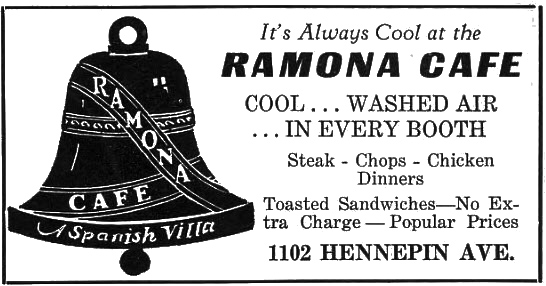
1931
Abe had a license to run the hotel from at least 1931 to 1933.
1933
Millie got a Tavern (3.2 beer) license for 1102 Hennepin on November 28, 1933.
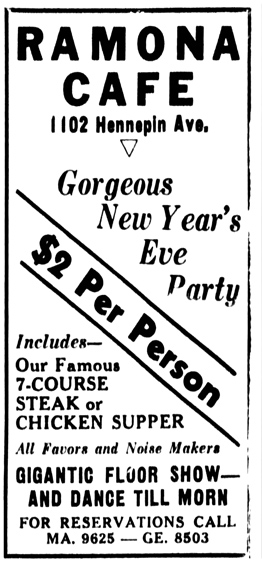
1934
Apparently getting a liquor license for the Ramona wasn’t easy for the Percanskys. This article appeared in the Minneapolis Star on March 9, 1934:
During the committee session, a heated argument arose over the application of the Ramona cafe, 1002 Hennepin avenue, operated by M.A. Percansky. Capt. A. C. Jensen, head of the police license inspection division, produced records showing Percansky in 1923 was arrested on a charge of assault with a deadly weapon, and later on a disorderly conduct charge.
“I’d never give that dirty rat a license,” Alderman O.A. Pearson interjected. “He’s been up her all the time, and I object to his continual hollering before the council.”
Percansky admitted he had been arrested “once or twice,” but contended he had never been convicted and that for the last 11 years, he has “been all right, and am now running a legitimate business.”
But from the ad below we see that they prevailed, as long as it was in Millie’s name.
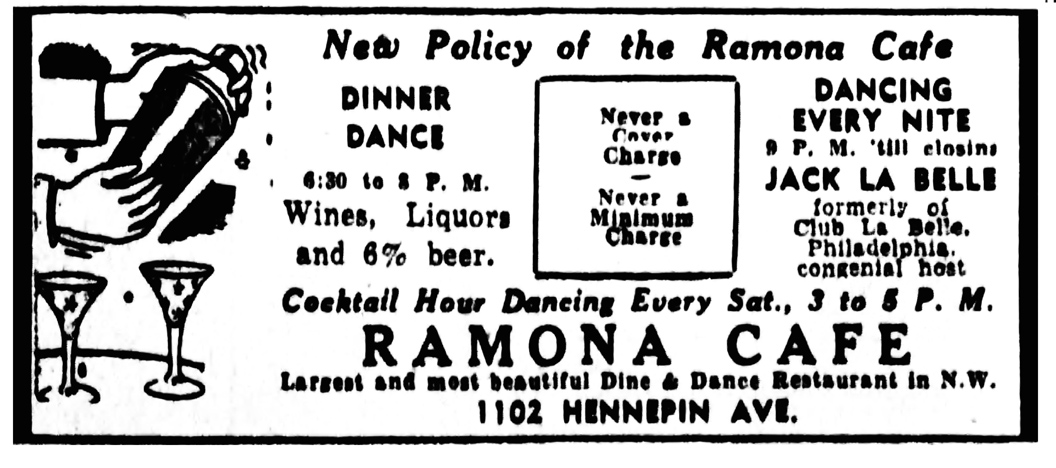
1935
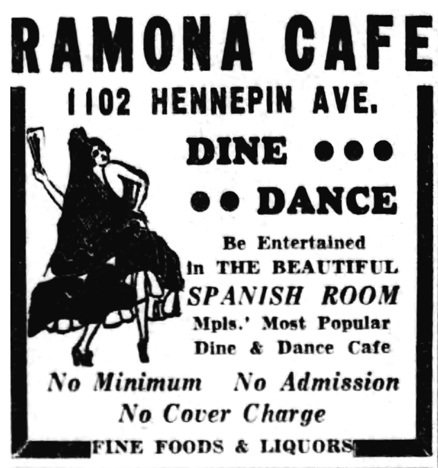
In the ad below – do you ‘spose Congenial Host Micque Cohn pronounced his name Mickey?
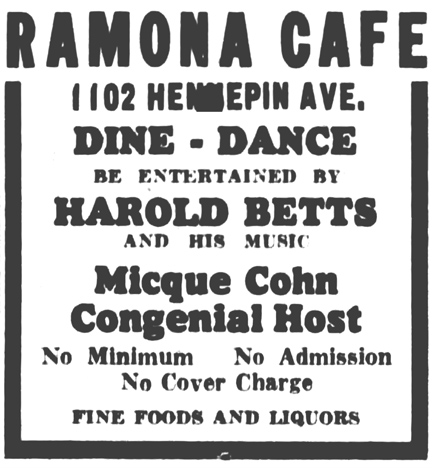
In the 1930s, there was a column, ostensibly by Walter Winchell, the New York gossip columnist, that “Tells You Why to go Where!” How he knew about hot spots in Minneapolis was a mystery, but on November 8, 1935, he highlighted the Ramona Cafe, saying, in his own, special vernacular:
Eater-cuters know it’s fun to drop in at the Ramona Cafe – where there’s dancing very eve’g to Maurice Pischa and his musickers – grand food, f’rixample, the steaks and sea food – and no extra fee tacked on to your bill.
Matchbook below from the collection of Mark Youngblood.
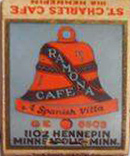
TROUBLE AT THE RAMONA
1937
In October 1937, Aileen Fletcher, 21, was fined $25 for operating a “Bing” game at the Ramona – a gambling game with dice. (Minneapolis Star, October 20, 1937)
1938
On August 29, 1938, there was a street brawl near the Ramona, now run by Dorothy Garfinkle. One young man was killed. Charges were filed against Garfinkle for serving beer to a minor, selling liquor without a license, selling liquor to minors, and running a “14” Game (Gambling). A jury found her guilty, and she was sentenced to a $100 fine or 60 days in the Workhouse.
In December 1938, the liquor license of the the Ramona was transferred to Abe’s new club, the Happy Hour.
1102 Hennepin became the home of Surplus Supply House through the 1940s.
Jerome Kelman was identified as the operator of a tavern at 1102 Hennepin from about May to July 1950.
HARRY’S TAVERN
In December 1951 there was a reference to Mrs. Helen Braman, who held a 3.2 license for Harry’s Tavern, in trouble for serving beer to minors. In January 1952, a painter was painting murals at Harry’s Tap Room, when a thief stole his coat, hat, etc.
In 1952 the beer license was transferred from Helen Braman to Alex Ostrowsky.
In May 1958 it was again (or still) Harry’s Tap Room.
MOUSEY’S BAR I
1102 Hennepin became Mousey’s Bar by August 1958, perhaps earlier. Mousey’s was not a music venue – one most likely heard Country music on the jukebox.
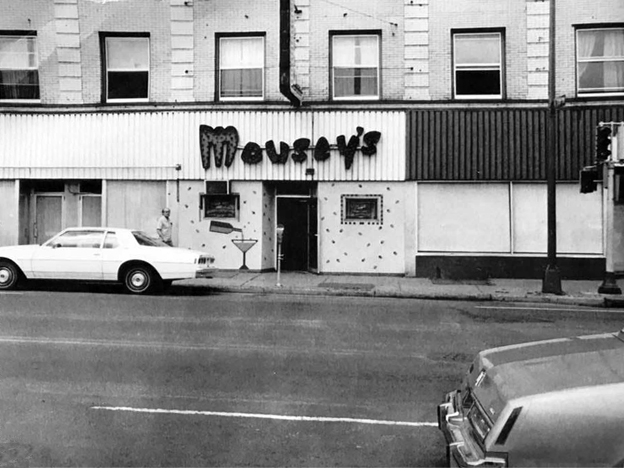
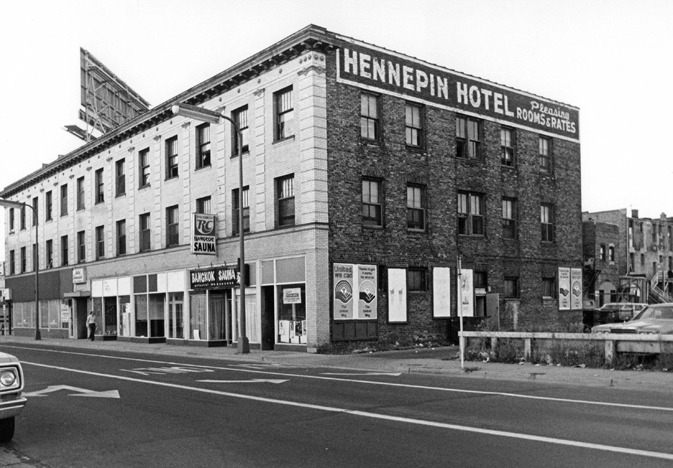
MOUSEY
Information about Mousey came from an interview with Holly Rae, his daughter, with thanks.
It turns out that Mousey was none other than Alex Ostrowsky, who had operated the place as Harry’s Tap Room since 1952. Alex’s father was a tailor for the Czar in Odessa; when he came to America he shoveled coal, and became a mob strong arm man, collecting debts. “Al,” as Holly called him, grew up in the Bronx. He was shot as a kid and thrown in the East River, fished out by a garbage scow. He ran numbers, and “could get out of anything.” His moniker came from the fact that he had big ears. He was recruited to play pro baseball, and could pitch a ball “through a mouse hole.”
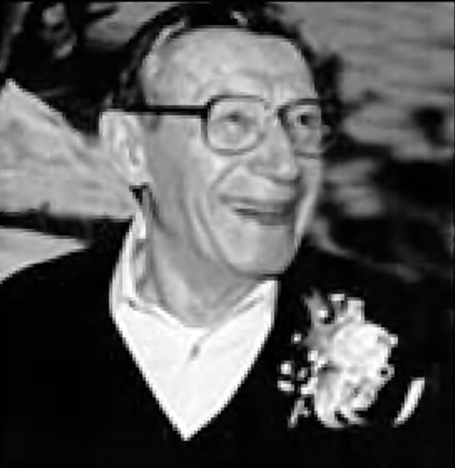
Mousie was a medic in the Army, and was one of the first to enter Auschwitz. He hated Germans. When he returned from the War he owned two or three bars on the Iron Range in his early 20s. He was a gambler, but never went to jail. He lost one of his bars on a flip of a coin. Before he had Harry’s he had managed Augie’s, and had been a bartender at the Lincoln Del. He was the handball champion at the YMCA, and often bailed people out of jail.
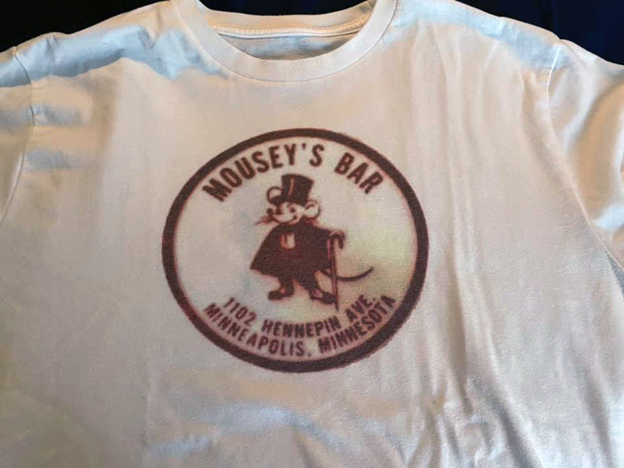
Holly, who worked at the bar for five years in her 20s, called it the “worst, toughest bar in Minneapolis.” It was located amidst day labor businesses and adult bookstores, and the Hennepin Hotel was run down and full of prostitutes. Patrons were often fighting with each other, and she was often “terrified.” She spoke of riding her bike from the Knollwood area of St. Louis Park to the bar, and this was in a bike-unfriendly world.
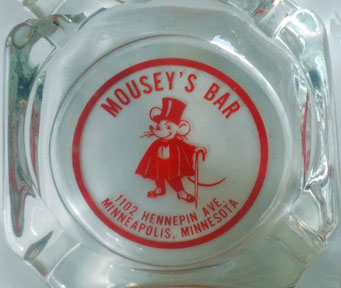
Facebook Facts:
Mouseys was often mentioned by Dave Moore on the Bedtime Newz!
“I use to joke with my friends that I could take my oldest, most worn out clothes, have a bus run over them a few times before I put them on, and still be the best dressed guy in the bar.”
In June 1960, the City received a request from George Bliss, who owned the Congress Bar in the doomed Skid Row, to transfer his liquor license to 1102 Hennepin, which was still a 3.2 tavern.

FIRE
On November 30, 1980, a four-alarm fire destroyed the Hennepin Hotel and Mousey’s with it. A janitor at Mousey’s was killed in the fire. Four others were taken to the hospital with injuries. The Red Cross assisted 60 people with food, clothing, and shelter at the Andrews Hotel. It was the third fire in the building in four months: two people were seriously injured in a fire on July 10, and another fire broke out on July 22 but no one was injured. (Minneapolis Tribune, December 1, 1980)
The fire left the building a charred shell, and a crane from Carl Bolander and Sons had to be brought in to empty it out in order to dump the smoldering insides onto the street and extinguish the remains. Holly Rae remembers standing out on the street for 24 hours, making sure to retrieve the safe among the ruins per her father’s instructions. Mousey himself had been in the hospital for prostate surgery for 28 days.
The fire was believed to have started in a kitchen ceiling at Mousey’s and could have been burning a while before a janitor discovered it. Two other businesses were destroyed: The Bangkok Sauna, and a Catholic Charities feeding center called The Branch 2, which had just opened in February 1980.
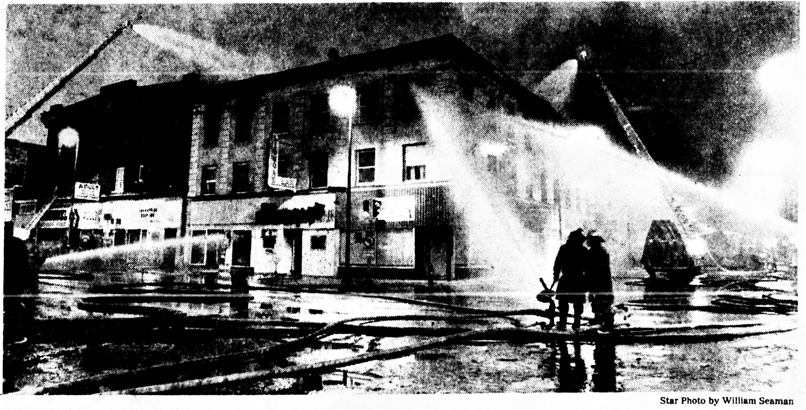
On November 30, 2000, the Star Tribune reported that the fire at the Hennepin Hotel had always been suspected of being arson, and there was always a suspect in mind. The man had been connected to several other instances of arson, and had threatened to burn down Mousey’s after he was kicked out by a bartender. In addition, a gas station attendant remembers him buying gas an hour before the fire, the janitor who survived said he smelled gas coming from the apartment above the bar, and the now-Fire Chief was convinced that an accelerant must have been used to fuel such a fast-burning fire.
The hotel at 1102 Hennepin Ave. was demolished in January 1981. It was replaced by the Hennepin Crossings Apartment Complex.
MOUSEY’S TOO
Mousey gave up the bar and ran operated another one for several years. In 1984, he started up Mousey’s again at 1110 Hennepin Ave., which was formerly the Carousel Bar.
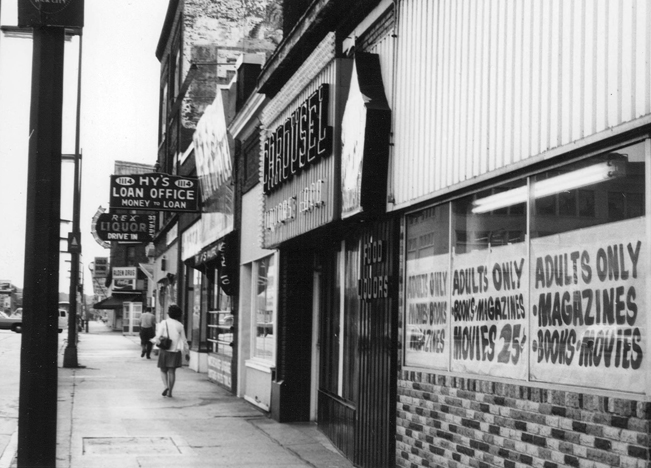
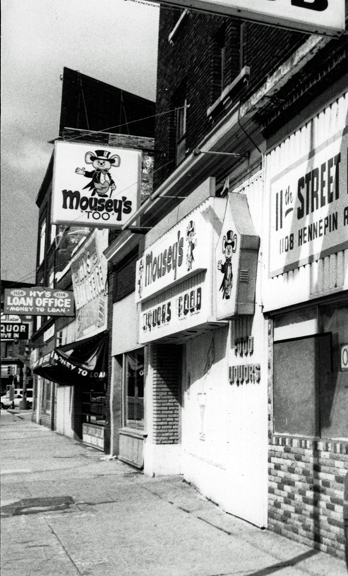
That building was scheduled to be demolished in August 1987, but things were so out of control that the City Council was trying to get the bar to shut down the June before. One police officer testified that Mousey’s had become a “festering sore.” Mousey claimed that he was being unfairly targeted, but the police countered with statistics:
- In 1986, police were called to the bar 285 times; drinking or violent behavior accounted for 177 of those calls.
- In the first five months of 1987, there were 180 calls to the bar.
Based on these statistics, Mousey’s was given a five day suspension starting July 1, 1987.
The bar soon closed for good, and the entire block was demolished for the Laurel Village Apartments development.
MOUSEY’S BAR III
In Jun 1989, Mousey applied for yet another liquor license, this time for a location at 1019 Currie Ave. N. The application was rejected 2-0 by the license committee, because of Mousey’s record, and because the location was close to the Salvation Army, Catholic Charities, and the Regency Hotel.
No more was said, so let’s assume that Mousey went into retirement.
Alex “Mousey” Ostrowsky died on April 28, 2011, at age 94, of complications of the flu. His obituary read,
An Urban Legend, and great man of Minneapolis was knocked down in the 94th round by flu complications in St. Louis Park.


